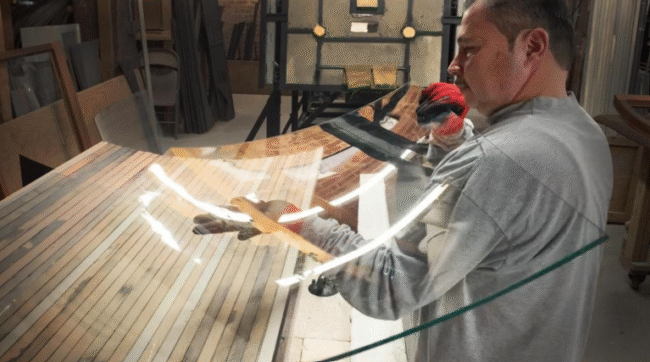
As climate change becomes more urgent, homeowners and designers are looking inward—literally—to make a difference. Sustainable building and interior design aren’t just trends; they’re critical tools in reducing carbon footprints and preserving the environment. From selecting eco-friendly materials to optimizing natural light, every choice in a home can make an impact. One design element that perfectly marries aesthetic appeal with green living is the curved window.
With their soft lines, panoramic views, and ability to flood rooms with natural light, curved windows offer both beauty and efficiency. When paired with sustainable décor, they transform living spaces into eco-conscious sanctuaries that feel both elevated and environmentally responsible. In this article, we’ll explore the appeal of curved windows, how they’re made, and how to style them using sustainable principles and materials.
Why Sustainable Building Matters
Before we dive into the design, it’s worth understanding why building sustainably is so essential. Residential and commercial buildings account for nearly 39% of global carbon emissions, largely due to construction materials, energy use, and waste. Every decision—from the type of glass in your windows to the fibers in your curtains—contributes to this footprint.
Choosing eco-friendly materials, maximizing energy efficiency, and designing with longevity in mind can significantly reduce a home’s environmental impact. Sustainable design isn’t about sacrificing style; it’s about creating spaces that are as kind to the earth as they are to the people living in them. Curved windows, especially when made from advanced energy-efficient glass and paired with thoughtful décor, are a perfect example of this balance.
The Allure of Curved Windows
Curved windows offer a softer, more organic aesthetic than traditional rectangular panes. From arched windows to bow and bay configurations, these designs break up the boxiness of typical interiors and provide a more immersive connection to the outdoors. They also allow for increased natural light, which can reduce reliance on artificial lighting and lower electricity consumption.
Curved windows are particularly suited to homes that prioritize biophilic design—the practice of integrating natural elements into living spaces to promote well-being and sustainability. Their architectural flow encourages the eye to move gently around a space, creating a sense of calm and openness.
How Curved Glass is Made (and Why It Matters)
One of the key differences between a standard window and a curved one lies in the manufacturing process. Curved glass isn’t simply bent, it’s carefully crafted through a precise, high-temperature process that ensures durability, safety, and optical clarity.
The Process:
• Heating: Flat glass is heated to temperatures between 600°C and 700°C, making it malleable without melting.
• Shaping: The softened glass is then placed over a mold. Depending on the technique used, it may be bent by gravity (letting it naturally conform to the mold) or through mechanical pressing.
• Cooling: Once the desired shape is achieved, the glass is cooled gradually in a controlled process called annealing (for standard curved glass) or tempering (for safety glass). This step locks in the curvature and increases structural strength.
Sustainability Considerations:
While curved glass does require more energy to produce than flat glass, its benefits can outweigh the costs—especially when energy-efficient coatings or double glazing are added. Innovations in manufacturing are also making it possible to incorporate recycled content and reduce emissions during production.
In practical terms, curved windows can enhance passive solar heating in colder months and reduce the need for artificial lighting, resulting in lower energy bills and a smaller carbon footprint over time.
Eco-Friendly Window Treatments That Work with Curved Glass
Styling a curved window presents a unique design challenge, but it also opens the door to creative and sustainable solutions. Here’s how to keep your treatments green:
Material Matters
• Organic Cotton & Linen: Naturally breathable and biodegradable, these fabrics are ideal for soft, flowing curtains.
• Hemp & Bamboo: Fast-growing and resource-efficient, they make excellent eco-friendly blinds and shades.
• Recycled Fabrics: Many manufacturers now offer curtains made from post-consumer textiles or plastic bottles.
Functional Considerations
• Custom Tracks & Bendable Rods: These can follow the shape of a bow or bay window and are often made from aluminum, which is recyclable.
• Layered Insulation: Thermal linings or layered drapes help regulate temperature, reducing heating and cooling needs.
For a DIY approach, consider repurposing old sheets or tablecloths into unique, upcycled window coverings that drape naturally around the curves.
Styling Around the Curve: Furniture and Accents
Curved windows often create cozy alcoves and semi-circular spaces that lend themselves beautifully to built-in seating or thoughtfully arranged furniture.
Eco-Friendly Ideas:
• Reclaimed Wood Benches or Sills: Custom seating that follows the curve of the window not only maximizes space but can be crafted from salvaged wood for rustic charm.
• Natural Fiber Textiles: Organic wool or cotton cushions, handwoven throws, and rugs made from jute or sisal enhance the warmth and earthiness of the space.
• Low-VOC Finishes: When painting or refinishing nearby furniture, opt for low-VOC (volatile organic compounds) products to improve indoor air quality.
Think minimalist and functional—let the window be the centerpiece, and use sustainable accent pieces to highlight its shape.
Plant Placement and Greenery Integration
Curved windows and natural light are a match made in eco-heaven for indoor plants. Whether you’re creating a sunny nook or a jungle-like ledge, greenery adds life and purifies the air.
Plant Tips:
• Best Choices: Snake plants, pothos, peace lilies, and ferns all thrive in bright indirect light.
• Sustainable Planters: Choose ceramic pots, clay, repurposed baskets, or even DIY containers made from upcycled jars and cans.
• Vertical or Hanging Gardens: Use macramé plant hangers made from natural fibers to accentuate the window’s shape without blocking light.
Plants not only improve mood and air quality—they’re a visual nod to your commitment to nature.
Lighting and Décor Enhancements
When the sun goes down, sustainable lighting keeps the vibe alive. Opt for:
• Solar-Powered Accent Lights: Especially for window sills or nearby shelving.
• LED Lamps with Natural Bases: Look for bamboo, driftwood, or recycled glass lamp bases.
• Eco Art: Wall hangings made from reclaimed metal, woven fabrics, or salvaged wood pieces.
The key is to choose décor that complements the curve without overwhelming it. Let light, texture, and simplicity guide your choices.
Curved windows offer more than just architectural flair—they open up a world of possibilities for sustainable, thoughtful design. From their unique glass construction to the way they invite natural light and organic flow, curved windows are a perfect partner for eco-friendly living.
By choosing sustainable materials, integrating natural elements, and making smart styling decisions, you can turn any curved window into a green centerpiece. In a world where every design choice matters, this is one view worth investing in.
